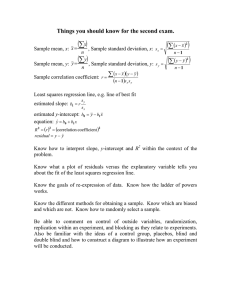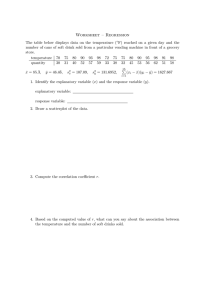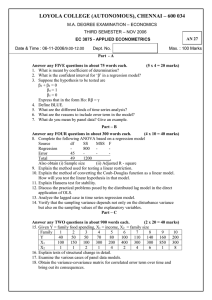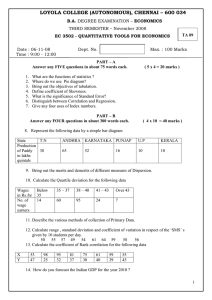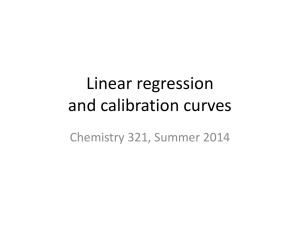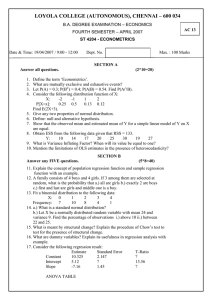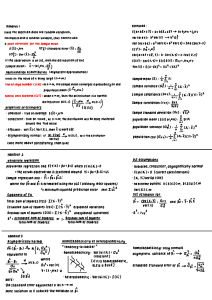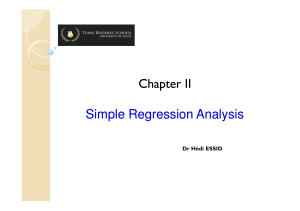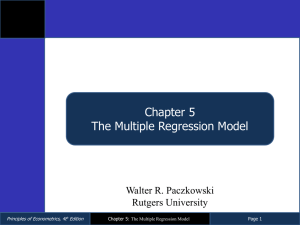LOYOLA COLLEGE (AUTONOMOUS), CHENNAI –600 034 B.A., DEGREE EXAMINATION - ECONOMICS
advertisement
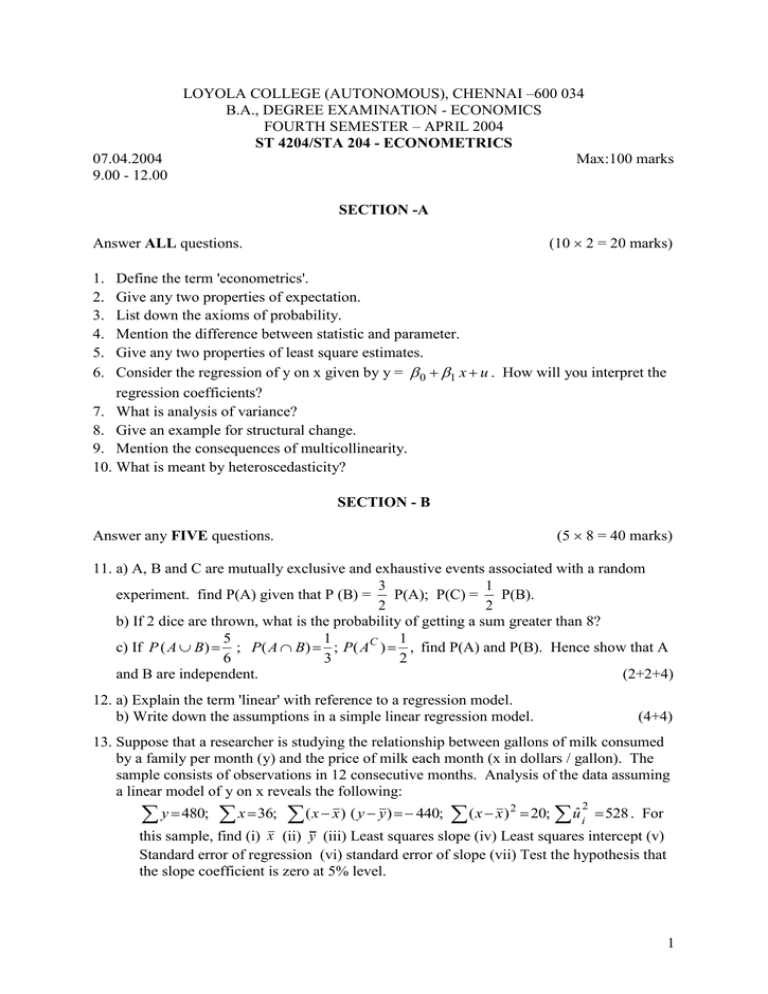
07.04.2004
9.00 - 12.00
LOYOLA COLLEGE (AUTONOMOUS), CHENNAI –600 034
B.A., DEGREE EXAMINATION - ECONOMICS
FOURTH SEMESTER – APRIL 2004
ST 4204/STA 204 - ECONOMETRICS
Max:100 marks
SECTION -A
(10 2 = 20 marks)
Answer ALL questions.
1.
2.
3.
4.
5.
6.
Define the term 'econometrics'.
Give any two properties of expectation.
List down the axioms of probability.
Mention the difference between statistic and parameter.
Give any two properties of least square estimates.
Consider the regression of y on x given by y = 0 1 x u . How will you interpret the
regression coefficients?
7. What is analysis of variance?
8. Give an example for structural change.
9. Mention the consequences of multicollinearity.
10. What is meant by heteroscedasticity?
SECTION - B
Answer any FIVE questions.
(5 8 = 40 marks)
11. a) A, B and C are mutually exclusive and exhaustive events associated with a random
3
1
experiment. find P(A) given that P (B) =
P(A); P(C) =
P(B).
2
2
b) If 2 dice are thrown, what is the probability of getting a sum greater than 8?
5
1
1
c) If P ( A B) ; P( A B) ; P( AC ) , find P(A) and P(B). Hence show that A
6
3
2
and B are independent.
(2+2+4)
12. a) Explain the term 'linear' with reference to a regression model.
b) Write down the assumptions in a simple linear regression model.
(4+4)
13. Suppose that a researcher is studying the relationship between gallons of milk consumed
by a family per month (y) and the price of milk each month (x in dollars / gallon). The
sample consists of observations in 12 consecutive months. Analysis of the data assuming
a linear model of y on x reveals the following:
y 480; x 36; ( x x ) ( y y ) 440; ( x x ) 2 20; uˆ i
2
528 . For
this sample, find (i) x (ii) y (iii) Least squares slope (iv) Least squares intercept (v)
Standard error of regression (vi) standard error of slope (vii) Test the hypothesis that
the slope coefficient is zero at 5% level.
1
14. Consider the following data set:
Sample No:
1
2
3
4
5
y : 15
10
14
8
3
x:
1
2
3
4
5
i) Calculate the least square estimates for 0 and 1 assuming the model
y = 0 1 x u for the above data.
ii) Calculate ŷ for each sample.
iii) Calculate TSS and RSS.
iv) Calculate the coefficient of determination.
15. Justify / interpret the following statements:
i)
P { - 0.725 < 1 < 2.35} = 0.90
ii)
R2 = 0.6735
iii)
the estimates obtained by the least squares method are the best when compared
with the estimates obtained by some other method.
iv)
uˆi2 0 .
16. Explain the concept of interval estimation.
17. What are dummy variables? Explain how the data matrix is specified in the presence of
dummy variables.
18. Explain the method of Generalized least squares.
SECTION - C
(2 20 = 40 marks)
Answer any TWO questions.
19. a) The joint probability distribution of two random variables X and Y in given by
X
-1
Y
-1
0
1
0
0
0
0
1
0
1/3
0
0
1/3 1/3
find i) the marginal distribution of X and Y.
ii) Var(X), Var(Y)
iii) Cov(X,Y)
iv) Conditional probability of X given Y = 1.
v) Var(X + Y)
b) Define: Independent events, mutually exclusive events and sample space.
(15+5)
2
20. a) Explain the test of overall significance of a multiple regression.
b) Consider the following ANOVA table:
SOURCE
All Variables
(X1, X2, X3, X4)
First two
Variables (X1, X2)
Difference
Residual
df
Sum of
Squares
?
800
?
300
?
?
?
?
Total
25
1500
i)
Complete the table by filling the missing values.
ii)
Test H0: 1 = 2 = 3 = 4 = 0
Vs
H1 : atleast one k 0, k = 1,2,3,4 at 5% level
iii)
Test H0: 1 = 2 = 0
Vs
H1: 1 0 (or) 2 0 at 5% level.
iv)
Test H0 : 3 = 4 = 0 Vs H1: 3 0 (or) 4 0 at 1% level
(8+12)
21. a) Consider the following data
y
X1
X2
1
1
2
3
2
1
8
3
-3
Based on this data, estimate the following regressions:
yi = 0+ 1 X1 i + u1i
yi = 0 + 1X1i+ 2X2i +u2i
Is 1 = 1? Why or why not?
b) i) Explain the concept of structural change.
ii) Give the steps involved in 'Chow test' to test for structural change.
(10+10)
22. a) Explain the remedial measures for multicollinearity.
b) Write short notes on:
i)
Coefficient of determination
ii)
Statistical inference
iii)
Random variables.
(10+10)
3
